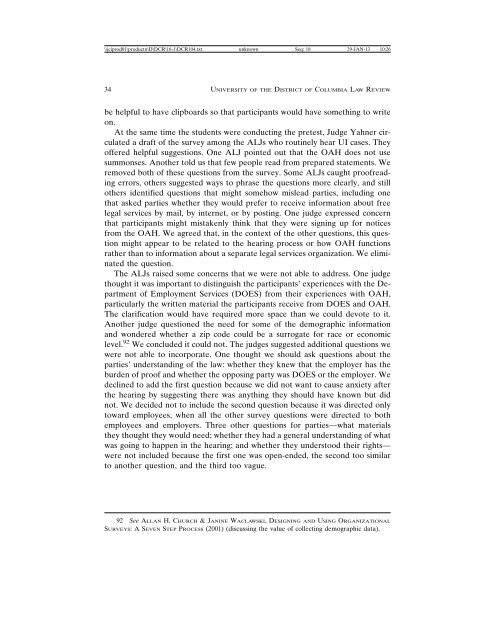volume 16, number 1 - UDC Law Review
volume 16, number 1 - UDC Law Review
volume 16, number 1 - UDC Law Review
- No tags were found...
Create successful ePaper yourself
Turn your PDF publications into a flip-book with our unique Google optimized e-Paper software.
\\jciprod01\productn\D\DCR\<strong>16</strong>-1\DCR104.txt unknown Seq: 18 29-JAN-13 10:2634 UNIVERSITY OF THE DISTRICT OF COLUMBIA LAW REVIEWbe helpful to have clipboards so that participants would have something to writeon.At the same time the students were conducting the pretest, Judge Yahner circulateda draft of the survey among the ALJs who routinely hear UI cases. Theyoffered helpful suggestions. One ALJ pointed out that the OAH does not usesummonses. Another told us that few people read from prepared statements. Weremoved both of these questions from the survey. Some ALJs caught proofreadingerrors, others suggested ways to phrase the questions more clearly, and stillothers identified questions that might somehow mislead parties, including onethat asked parties whether they would prefer to receive information about freelegal services by mail, by internet, or by posting. One judge expressed concernthat participants might mistakenly think that they were signing up for noticesfrom the OAH. We agreed that, in the context of the other questions, this questionmight appear to be related to the hearing process or how OAH functionsrather than to information about a separate legal services organization. We eliminatedthe question.The ALJs raised some concerns that we were not able to address. One judgethought it was important to distinguish the participants’ experiences with the Departmentof Employment Services (DOES) from their experiences with OAH,particularly the written material the participants receive from DOES and OAH.The clarification would have required more space than we could devote to it.Another judge questioned the need for some of the demographic informationand wondered whether a zip code could be a surrogate for race or economiclevel. 92 We concluded it could not. The judges suggested additional questions wewere not able to incorporate. One thought we should ask questions about theparties’ understanding of the law: whether they knew that the employer has theburden of proof and whether the opposing party was DOES or the employer. Wedeclined to add the first question because we did not want to cause anxiety afterthe hearing by suggesting there was anything they should have known but didnot. We decided not to include the second question because it was directed onlytoward employees, when all the other survey questions were directed to bothemployees and employers. Three other questions for parties—what materialsthey thought they would need; whether they had a general understanding of whatwas going to happen in the hearing; and whether they understood their rights—were not included because the first one was open-ended, the second too similarto another question, and the third too vague.92 See ALLAN H. CHURCH & JANINE WACLAWSKI, DESIGNING AND USING ORGANIZATIONALSURVEYS: A SEVEN STEP PROCESS (2001) (discussing the value of collecting demographic data).














